InSAR Analysis of Post-Liquefaction Consolidation Subsidence after 2012 Emilia Earthquake Sequence (Italy)
Abstract
:1. Introduction
2. The Case Study
2.1. The Seismic Sequence
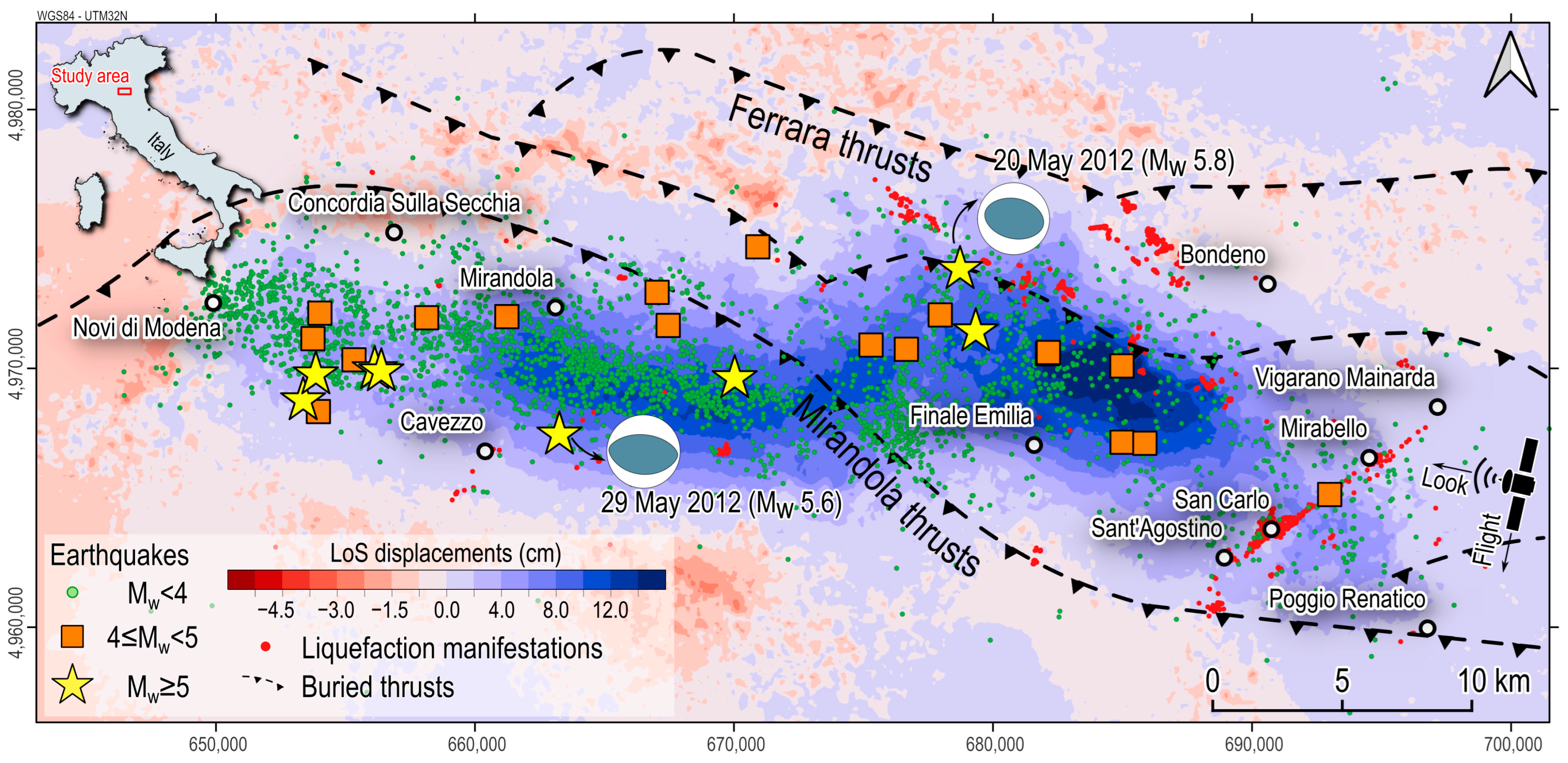
2.2. Lithological Setting of the Area

3. Data and Methods
3.1. SAR Data and Processing
3.2. Available Geotechnical Data and Assessment of the Post-Liquefaction Consolidation Subsidence
3.2.1. Sandy-Like Soils ()
3.2.2. Clay-Like Soils ()
4. Results
4.1. InSAR-Derived Ground Displacements
4.2. Identification and Estimation of Displacement Sources
4.3. Estimation of the Post-Liquefaction Consolidation Subsidence
5. Discussion
5.1. Other Potential Factors Producing Ground Subsidence
5.2. Conceptual Scheme of the Observed Phenomenon
5.3. Uncertainties and Further Developments
6. Conclusions
Supplementary Materials
Author Contributions
Funding
Data Availability Statement
Acknowledgments
Conflicts of Interest
References
- Obermeier, S.F. The New Madrid Earthquakes: An Engineering-Geologic Interpretation of Relict Liquefaction Features; Professional Paper; United States Government Printing Office: Washington, DC, USA, 1989. [Google Scholar]
- Seed, H.B. The Fourth Terzaghi Lecture: Landslides during Earthquakes Due to Liquefaction. J. Soil Mech. Found. Div. 1968, 94, 1053–1122. [Google Scholar] [CrossRef]
- Seed, H.B.; Idriss, I.M. Analysis of Soil Liquefaction: Niigata Earthquake. J. Soil Mech. Found. Div. 1967, 93, 83–108. [Google Scholar] [CrossRef]
- Sonmez, B.; Ulusay, R.; Sonmez, H. A Study on the Identification of Liquefaction-Induced Failures on Ground Surface Based on the Data from the 1999 Kocaeli and Chi-Chi Earthquakes. Eng. Geol. 2008, 97, 112–125. [Google Scholar] [CrossRef]
- Wang, C.; Dreger, D.S.; Wang, C.; Mayeri, D.; Berryman, J.G. Field Relations among Coseismic Ground Motion, Water Level Change and Liquefaction for the 1999 Chi-Chi (Mw = 7.5) Earthquake, Taiwan. Geophys. Res. Lett. 2003, 30, 2003GL017601. [Google Scholar] [CrossRef]
- Elgamal, A.-W.; Zeghal, M.; Parra, E. Liquefaction of Reclaimed Island in Kobe, Japan. J. Geotech. Engrg. 1996, 122, 39–49. [Google Scholar] [CrossRef]
- Quigley, M.C.; Bastin, S.; Bradley, B.A. Recurrent Liquefaction in Christchurch, New Zealand, during the Canterbury Earthquake Sequence. Geology 2013, 41, 419–422. [Google Scholar] [CrossRef]
- Minarelli, L.; Amoroso, S.; Civico, R.; De Martini, P.M.; Lugli, S.; Martelli, L.; Molisso, F.; Rollins, K.M.; Salocchi, A.; Stefani, M.; et al. Liquefied Sites of the 2012 Emilia Earthquake: A Comprehensive Database of the Geological and Geotechnical Features (Quaternary Alluvial Po Plain, Italy). Bull Earthq. Eng 2022, 20, 3659–3697. [Google Scholar] [CrossRef]
- Jalil, A.; Fathani, T.F.; Satyarno, I.; Wilopo, W. Liquefaction in Palu: The Cause of Massive Mudflows. Geoenviron. Disasters 2021, 8, 21. [Google Scholar] [CrossRef]
- Kramer, S.L. Geotechnical Earthquake Engineering; Prentice-Hall international series in civil engineering and engineering mechanics; Prentice Hall: Upper Saddle River, NJ, USA, 1996; ISBN 978-0-13-374943-4. [Google Scholar]
- Zeybek, A.; Madabhushi, G.S.P. Assessment of Soil Parameters during Post-Liquefaction Reconsolidation of Loose Sand. Soil Dyn. Earthq. Eng. 2023, 164, 107611. [Google Scholar] [CrossRef]
- Chiaradonna, A.; d’Onofrio, A.; Bilotta, E. Assessment of Post-Liquefaction Consolidation Settlement. Bull. Earthq. Eng. 2019, 17, 5825–5848. [Google Scholar] [CrossRef]
- Chini, M.; Albano, M.; Saroli, M.; Pulvirenti, L.; Moro, M.; Bignami, C.; Falcucci, E.; Gori, S.; Modoni, G.; Pierdicca, N.; et al. Coseismic Liquefaction Phenomenon Analysis by COSMO-SkyMed: 2012 Emilia (Italy) Earthquake. Int. J. Appl. Earth Obs. Geoinf. 2015, 39, 65–78. [Google Scholar] [CrossRef]
- Dashti, S.; Bray, J.D.; Pestana, J.M.; Riemer, M.; Wilson, D. Mechanisms of Seismically Induced Settlement of Buildings with Shallow Foundations on Liquefiable Soil. J. Geotech. Geoenviron. Eng. 2010, 136, 151–164. [Google Scholar] [CrossRef]
- Adamidis, O.; Madabhushi, S.P.G. Deformation Mechanisms under Shallow Foundations on Liquefiable Layers of Varying Thickness. Géotechnique 2017, 68, 602–613. [Google Scholar] [CrossRef]
- Albano, M.; Saroli, M.; Beccaro, L.; Moro, M.; Doumaz, F.; Discenza, M.E.; Del Rio, L.; Rompato, M. Multi-Source Data Analysis to Assess the Past and Present Kinematics of the Pisciotta Deep-Seated Gravitational Slope Deformation (Southern Italy). Remote Sens. Environ. 2023, 296, 113751. [Google Scholar] [CrossRef]
- Li, S.; Xu, W.; Li, Z. Review of the SBAS InSAR Time-Series Algorithms, Applications, and Challenges. Geod. Geodyn. 2022, 13, 114–126. [Google Scholar] [CrossRef]
- Lundgren, P.; Casu, F.; Manzo, M.; Pepe, A.; Berardino, P.; Sansosti, E.; Lanari, R. Gravity and Magma Induced Spreading of Mount Etna Volcano Revealed by Satellite Radar Interferometry. Geophys. Res. Lett. 2004, 31, 2003GL018736. [Google Scholar] [CrossRef]
- Beccaro, L.; Albano, M.; Tolomei, C.; Spinetti, C.; Pezzo, G.; Palano, M.; Chiarabba, C. Insights into Post-Emplacement Lava FLow Dynamics at Mt. Etna Volcano from 2016 to 2021 by Synthetic Aperture Radar and Multispectral Satellite Data. Front. Earth Sci. 2023, 11, 14. [Google Scholar] [CrossRef]
- Stramondo, S.; Trasatti, E.; Albano, M.; Moro, M.; Chini, M.; Bignami, C.; Polcari, M.; Saroli, M. Uncovering Deformation Processes from Surface Displacements. J. Geodyn. 2016, 102, 58–82. [Google Scholar] [CrossRef]
- Pousse-Beltran, L.; Socquet, A.; Benedetti, L.; Doin, M.; Rizza, M.; D’Agostino, N. Localized Afterslip at Geometrical Complexities Revealed by InSAR After the 2016 Central Italy Seismic Sequence. JGR Solid Earth 2020, 125, e2019JB019065. [Google Scholar] [CrossRef]
- Moro, M.; Saroli, M.; Stramondo, S.; Bignami, C.; Albano, M.; Falcucci, E.; Gori, S.; Doglioni, C.; Polcari, M.; Tallini, M.; et al. New Insights into Earthquake Precursors from InSAR. Sci. Rep. 2017, 7, 12035. [Google Scholar] [CrossRef]
- Cando-Jácome, M.; Martínez-Graña, A.; Chunga, K.; Ortíz-Hernández, E. Satellite Radar Interferometry for Assessing Coseismic Liquefaction in Portoviejo City, Induced by the Mw 7.8 2016 Pedernales, Ecuador Earthquake. Environ. Earth Sci. 2020, 79, 467. [Google Scholar] [CrossRef]
- Barnhart, W.D.; Yeck, W.L.; McNamara, D.E. Induced Earthquake and Liquefaction Hazards in Oklahoma, USA: Constraints from InSAR. Remote Sens. Environ. 2018, 218, 1–12. [Google Scholar] [CrossRef]
- Fujiwara, S.; Nakano, T.; Morishita, Y.; Kobayashi, T.; Yarai, H.; Une, H.; Hayashi, K. Detection and Interpretation of Local. Surface Deformation from the 2018 Hokkaido Eastern Iburi Earthquake Using ALOS-2 SAR Data. Earth Planets Space 2019, 71, 64. [Google Scholar] [CrossRef]
- Cheloni, D.; Giuliani, R.; D’Agostino, N.; Mattone, M.; Bonano, M.; Fornaro, G.; Lanari, R.; Reale, D.; Atzori, S. New Insights into Fault Activation and Stress Transfer between en Echelon Thrusts: The 2012 Emilia, Northern Italy, Earthquake Sequence. JGR Solid Earth 2016, 121, 4742–4766. [Google Scholar] [CrossRef]
- Govoni, A.; Marchetti, A.; De Gori, P.; Di Bona, M.; Lucente, F.P.; Improta, L.; Chiarabba, C.; Nardi, A.; Margheriti, L.; Agostinetti, N.P.; et al. The 2012 Emilia Seismic Sequence (Northern Italy): Imaging the Thrust Fault System by Accurate Aftershock Location. Tectonophysics 2014, 622, 44–55. [Google Scholar] [CrossRef]
- Scognamiglio, L.; Margheriti, L.; Mele, F.M.; Tinti, E.; Bono, A.; De Gori, P.; Lauciani, V.; Lucente, F.P.; Mandiello, A.G.; Marcocci, C.; et al. The 2012 Pianura Padana Emiliana Seimic Sequence: Locations, Moment Tensors and Magnitudes. Ann. Geophys. 2012, 55, 5. [Google Scholar] [CrossRef]
- Tizzani, P.; Castaldo, R.; Solaro, G.; Pepe, S.; Bonano, M.; Casu, F.; Manunta, M.; Manzo, M.; Pepe, A.; Samsonov, S.; et al. New Insights into the 2012 Emilia (Italy) Seismic Sequence through Advanced Numerical Modeling of Ground Deformation InSAR Measurements. Geophys. Res. Lett. 2013, 40, 1971–1977. [Google Scholar] [CrossRef]
- Albano, M.; Barba, S.; Solaro, G.; Pepe, A.; Bignami, C.; Moro, M.; Saroli, M.; Stramondo, S. Aftershocks, Groundwater Changes and Postseismic Ground Displacements Related to Pore Pressure Gradients: Insights from the 2012 Emilia-Romagna Earthquake: The 2012 Emilia-Romagna Earthquake. J. Geophys. Res. Solid Earth 2017, 122, 5622–5638. [Google Scholar] [CrossRef]
- Emergeo Working Group Liquefaction Phenomena Associated with the Emilia Earthquake Sequence of May–June 2012 (Northern Italy). Nat. Hazards Earth Syst. Sci. 2013, 13, 935–947. [CrossRef]
- Martelli, L.; Nardi, G.; Cavuoto, G.; Conforti, A.; Ferraro, L.; D’Argenio, B. Note Illustrative Della Carta Geologica d’Italia Alla Scala 1:50.000; Foglio 519 Capo Palinuro; Istituto Superiore per la Protezione e la Ricerca Ambientale: Regione Campania, Italy, 2016. [Google Scholar]
- Ghielmi, M.; Minervini, M.; Nini, C.; Rogledi, S.; Rossi, M.; Vignolo, A. Sedimentary and Tectonic Evolution in the Eastern Po-Plain and Northern Adriatic Sea Area from Messinian to Middle Pleistocene (Italy). Rend. Fis. Acc. Lincei 2010, 21, 131–166. [Google Scholar] [CrossRef]
- Marcaccio, M.; Martinelli, G. Effects on the Groundwater Levels of the May–June 2012 Emilia Seismic Sequence. Ann. Geophys. 2012, 55, 38. [Google Scholar] [CrossRef]
- Nespoli, M.; Todesco, M.; Serpelloni, E.; Belardinelli, M.E.; Bonafede, M.; Marcaccio, M.; Rinaldi, A.P.; Anderlini, L.; Gualandi, A. Modeling Earthquake Effects on Groundwater Levels: Evidences from the 2012 Emilia Earthquake (Italy). Geofluids 2016, 16, 452–463. [Google Scholar] [CrossRef]
- Nespoli, M.; Belardinelli, M.E.; Gualandi, A.; Serpelloni, E.; Bonafede, M. Poroelasticity and Fluid Flow Modeling for the 2012 Emilia-Romagna Earthquakes: Hints from GPS and InSAR Data. Geofluids 2018, 2018, 15. [Google Scholar] [CrossRef]
- Cinti, D.; Sciarra, A.; Cantucci, B.; Galli, G.; Pizzino, L.; Procesi, M.; Poncia, P.P. Hydrogeochemical Investigation of Shallow Aquifers before and after the 2012 Emilia Seismic Sequence (Northern Italy). Appl. Geochem. 2023, 151, 105624. [Google Scholar] [CrossRef]
- Di Manna, P.; Guerrieri, L.; Piccardi, L.; Vittori, E.; Castaldini, D.; Berlusconi, A.; Bonadeo, L.; Comerci, V.; Ferrario, F.; Gambillara, R.; et al. Ground Effects Induced by the 2012 Seismic Sequence in Emilia: Implications for Seismic Hazard Assessment in the Po Plain. Ann. Geophys. 2012, 55, 23. [Google Scholar] [CrossRef]
- Civico, R.; Brunori, C.A.; De Martini, P.M.; Pucci, S.; Cinti, F.R.; Pantosti, D. Liquefaction Susceptibility Assessment in Fluvial Plains Using Airborne Lidar: The Case of the 2012 Emilia Earthquake Sequence Area (Italy). Nat. Hazards Earth Syst. Sci. 2015, 15, 2473–2483. [Google Scholar] [CrossRef]
- Sinatra, L.; Foti, S. The Role of Aftershocks in the Liquefaction Phenomena Caused by the Emilia 2012 Seismic Sequence. Soil Dyn. Earthq. Eng. 2015, 75, 234–245. [Google Scholar] [CrossRef]
- Tentori, D.; Mancini, M.; Varone, C.; Spacagna, R.; Baris, A.; Milli, S.; Gaudiosi, I.; Simionato, M.; Stigliano, F.; Modoni, G.; et al. The Influence of Alluvial Stratigraphic Architecture on Liquefaction Phenomena: A Case Study from the Terre Del Reno Subsoil (Southern Po Plain, Italy). Sediment. Geol. 2022, 440, 106258. [Google Scholar] [CrossRef]
- Papathanassiou, G.; Mantovani, A.; Tarabusi, G.; Rapti, D.; Caputo, R. Assessment of Liquefaction Potential for Two Liquefaction Prone Areas Considering the May 20, 2012 Emilia (Italy) Earthquake. Eng. Geol. 2015, 189, 1–16. [Google Scholar] [CrossRef]
- Berardino, P.; Fornaro, G.; Lanari, R.; Sansosti, E. A New Algorithm for Surface Deformation Monitoring Based on Small Baseline Differential SAR Interferograms. IEEE Trans. Geosci. Remote Sens. 2002, 40, 2375–2383. [Google Scholar] [CrossRef]
- Ferretti, A.; Prati, C.; Rocca, F. Permanent Scatterers in SAR Interferometry. IEEE Trans. Geosci. Remote Sens. 2001, 39, 8–20. [Google Scholar] [CrossRef]
- Rosen, P.A.; Hensley, S.; Joughin, I.R.; Li, F.K.; Madsen, S.N.; Rodriguez, E.; Goldstein, R.M. Synthetic Aperture Radar Interferometry. Proc. IEEE 2000, 88, 333–382. [Google Scholar] [CrossRef]
- Goldstein, R.M.; Werner, C.L. Radar Interferogram Filtering for Geophysical Applications. Geophys. Res. Lett. 1998, 25, 4035–4038. [Google Scholar] [CrossRef]
- Pepe, A.; Lanari, R. On the Extension of the Minimum Cost Flow Algorithm for Phase Unwrapping of Multitemporal Differential SAR Interferograms. IEEE Trans. Geosci. Remote Sens. 2006, 44, 2374–2383. [Google Scholar] [CrossRef]
- Casu, F.; Manzo, M.; Lanari, R. A Quantitative Assessment of the SBAS Algorithm Performance for Surface Deformation Retrieval from DInSAR Data. Remote Sens. Environ. 2006, 102, 195–210. [Google Scholar] [CrossRef]
- Tizzani, P.; Berardino, P.; Casu, F.; Euillades, P.; Manzo, M.; Ricciardi, G.; Zeni, G.; Lanari, R. Surface Deformation of Long Valley Caldera and Mono Basin, California, Investigated with the SBAS-InSAR Approach. Remote Sens. Environ. 2007, 108, 277–289. [Google Scholar] [CrossRef]
- Cheloni, D.; De Novellis, V.; Albano, M.; Antonioli, A.; Anzidei, M.; Atzori, S.; Avallone, A.; Bignami, C.; Bonano, M.; Calcaterra, S.; et al. Geodetic Model of the 2016 Central Italy Earthquake Sequence Inferred from InSAR and GPS Data: Modeling 2016 Central Italy Earthquakes. Geophys. Res. Lett. 2017, 44, 6778–6787. [Google Scholar] [CrossRef]
- Manzo, M.; Fialko, Y.; Casu, F.; Pepe, A.; Lanari, R. A Quantitative Assessment of DInSAR Measurements of Interseismic Deformation: The Southern San Andreas Fault Case Study. Pure Appl. Geophys. 2012, 169, 1463–1482. [Google Scholar] [CrossRef]
- Pepe, A.; Yang, Y.; Manzo, M.; Lanari, R. Improved EMCF-SBAS Processing Chain Based on Advanced Techniques for the Noise-Filtering and Selection of Small Baseline Multi-Look DInSAR Interferograms. IEEE Trans. Geosci. Remote Sens. 2015, 53, 4394–4417. [Google Scholar] [CrossRef]
- Pepe, A.; Calò, F. A Review of Interferometric Synthetic Aperture RADAR (InSAR) Multi-Track Approaches for the Retrieval of Earth’s Surface Displacements. Appl. Sci. 2017, 7, 1264. [Google Scholar] [CrossRef]
- Manunta, M.; De Luca, C.; Zinno, I.; Casu, F.; Manzo, M.; Bonano, M.; Fusco, A.; Pepe, A.; Onorato, G.; Berardino, P.; et al. The Parallel SBAS Approach for Sentinel-1 Interferometric Wide Swath Deformation Time-Series Generation: Algorithm Description and Products Quality Assessment. IEEE Trans. Geosci. Remote Sens. 2019, 57, 6259–6281. [Google Scholar] [CrossRef]
- Krige, D.G. A Statistical Approach to Some Basic Mine Valuation Problems on the Witwatersrand. J. Chem. Metall. Min. Sociaty S. Afr. 1951, 52, 119–139. [Google Scholar]
- Oliver, M.A.; Webster, R. A Tutorial Guide to Geostatistics: Computing and Modelling Variograms and Kriging. CATENA 2014, 113, 56–69. [Google Scholar] [CrossRef]
- Saroli, M.; Albano, M.; Modoni, G.; Moro, M.; Milana, G.; Spacagna, R.-L.; Falcucci, E.; Gori, S.; Scarascia Mugnozza, G. Insights into Bedrock Paleomorphology and Linear Dynamic Soil Properties of the Cassino Intermontane Basin (Central Italy). Eng. Geol. 2020, 264, 105333. [Google Scholar] [CrossRef]
- Spadi, M.; Tallini, M.; Albano, M.; Cosentino, D.; Nocentini, M.; Saroli, M. New Insights on Bedrock Morphology and Local Seismic Amplification of the Castelnuovo Village (L’Aquila Basin, Central Italy). Eng. Geol. 2022, 297, 106506. [Google Scholar] [CrossRef]
- Pebesma, E.J. Multivariable Geostatistics in S: The Gstat Package. Comput. Geosci. 2004, 30, 683–691. [Google Scholar] [CrossRef]
- Varone, C.; Carbone, G.; Baris, A.; Caciolli, M.C.; Fabozzi, S.; Fortunato, C.; Gaudiosi, I.; Giallini, S.; Mancini, M.; Paolella, L.; et al. PERL: A Dataset of Geotechnical, Geophysical, and Hydrogeological Parameters for Earthquake-Induced Hazards Assessment in Terre Del Reno (Emilia-Romagna, Italy). Nat. Hazards Earth Syst. Sci. 2023, 23, 1371–1382. [Google Scholar] [CrossRef]
- Robertson, P.K. Soil Behaviour Type from the CPT: An Update. In Proceedings of the 2nd International Symposium on Cone Penetration Testing, Huntington Beach, CA, USA, 9–11 May 2010; Volume 2, pp. 575–583. [Google Scholar]
- Terzaghi, K. Theoretical Soil Mechanics; John Wiley & Sons, Inc.: Hoboken, NJ, USA, 1943; ISBN 978-0-470-17276-6. [Google Scholar]
- Robertson, P.K.; Cabal, K. Guide to Cone Penetration Testing, 7th ed.; Gregg Drilling LLC: Benicia, CA, USA, 2022. [Google Scholar]
- Matsui, T.; Ohara, H.; Ito, T. Cyclic Stress-Strain History and Shear Characteristics of Clay. J. Geotech. Engrg. Div. 1980, 106, 1101–1120. [Google Scholar] [CrossRef]
- Linee Guida dell’Associazione Geotecnica Italiana. AGI Aspetti Geotecnici Della Progettazione in Zona Sismica; Linee Guida dell’Associazione Geotecnica Italiana: Rome, Italy, 2005. [Google Scholar]
- Hardin, B.O.; Drnevich, V.P. Shear Modulus and Damping in Soils: Design Equations and Curves. J. Soil Mech. Found. Div. 1972, 98, 667–692. [Google Scholar] [CrossRef]
- Kramer, S.L.; Sideras, S.S.; Greenfield, M.W. The Timing of Liquefaction and Its Utility in Liquefaction Hazard Evaluation. Soil. Dyn. Earthq. Eng. 2016, 91, 133–146. [Google Scholar] [CrossRef]
- Brunori, C.A.; Murgia, F. Spatiotemporal Evolution of Ground Subsidence and Extensional Basin Bedrock Organization: An Application of Multitemporal Multi-Satellite SAR Interferometry. Geosciences 2023, 13, 105. [Google Scholar] [CrossRef]
- Dalla Via, G.; Crosetto, M.; Crippa, B. Resolving Vertical and East-West Horizontal Motion from Differential Interferometric Synthetic Aperture Radar: The L’Aquila Earthquake. J. Geophys. Res. Solid Earth 2012, 117, 14. [Google Scholar] [CrossRef]
- Carminati, E.; Di Donato, G. Separating Natural and Anthropogenic Vertical Movements in Fast Subsiding Areas: The Po Plain (N. Italy) Case. Geophys. Res. Lett. 1999, 26, 2291–2294. [Google Scholar] [CrossRef]
- Crameri, F.; Shephard, G.E.; Heron, P.J. The Misuse of Colour in Science Communication. Nat. Commun. 2020, 11, 5444. [Google Scholar] [CrossRef] [PubMed]
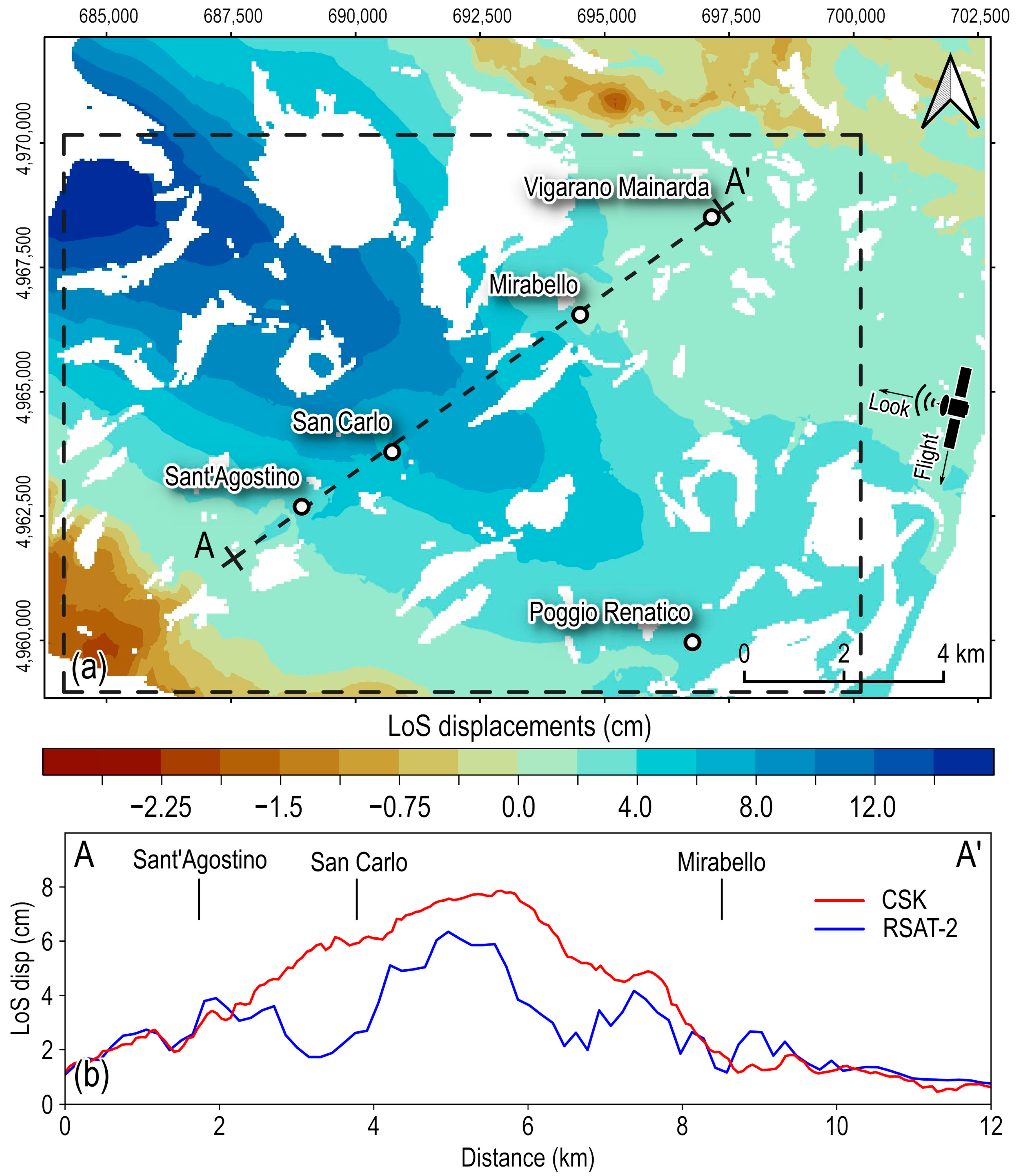
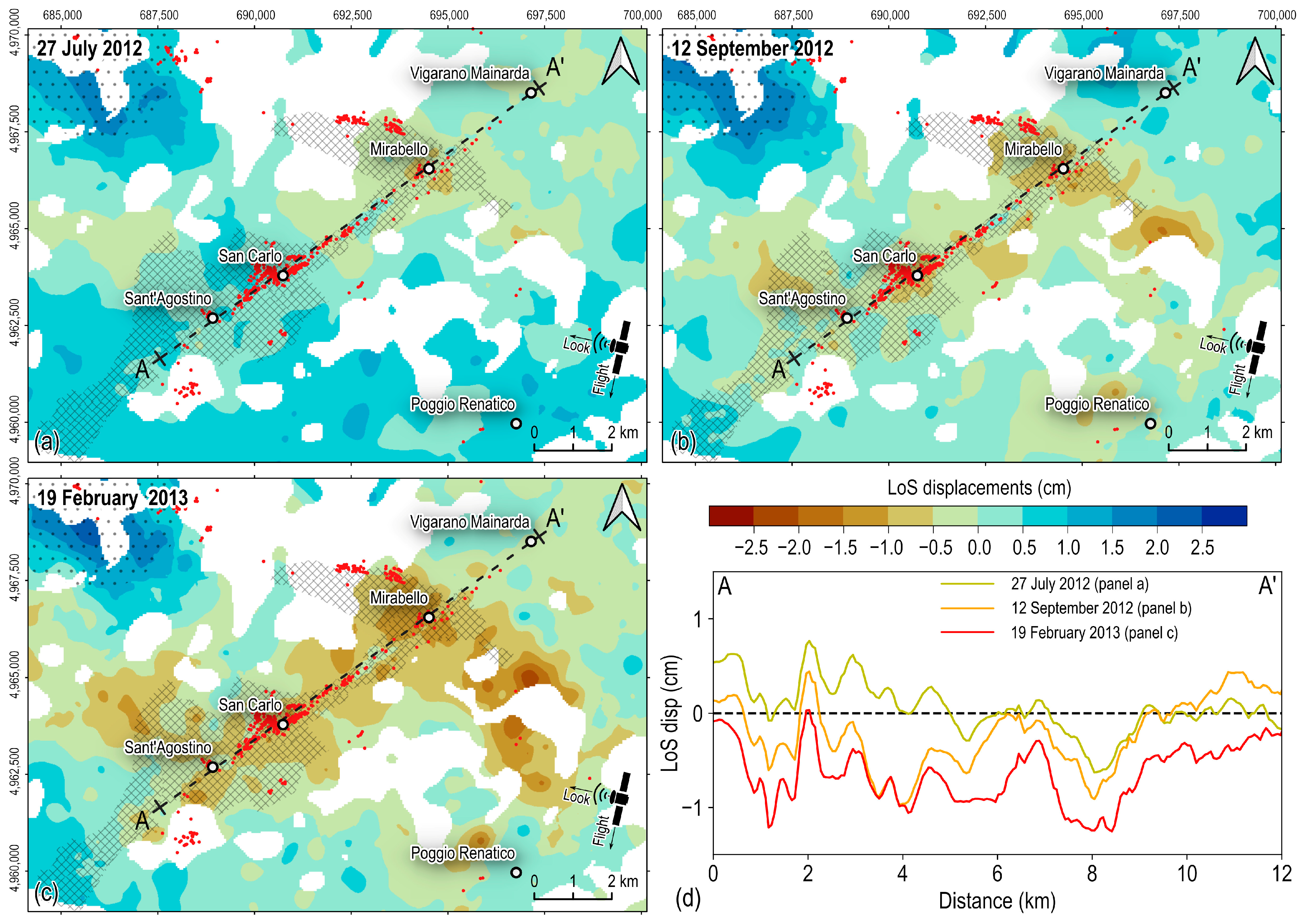
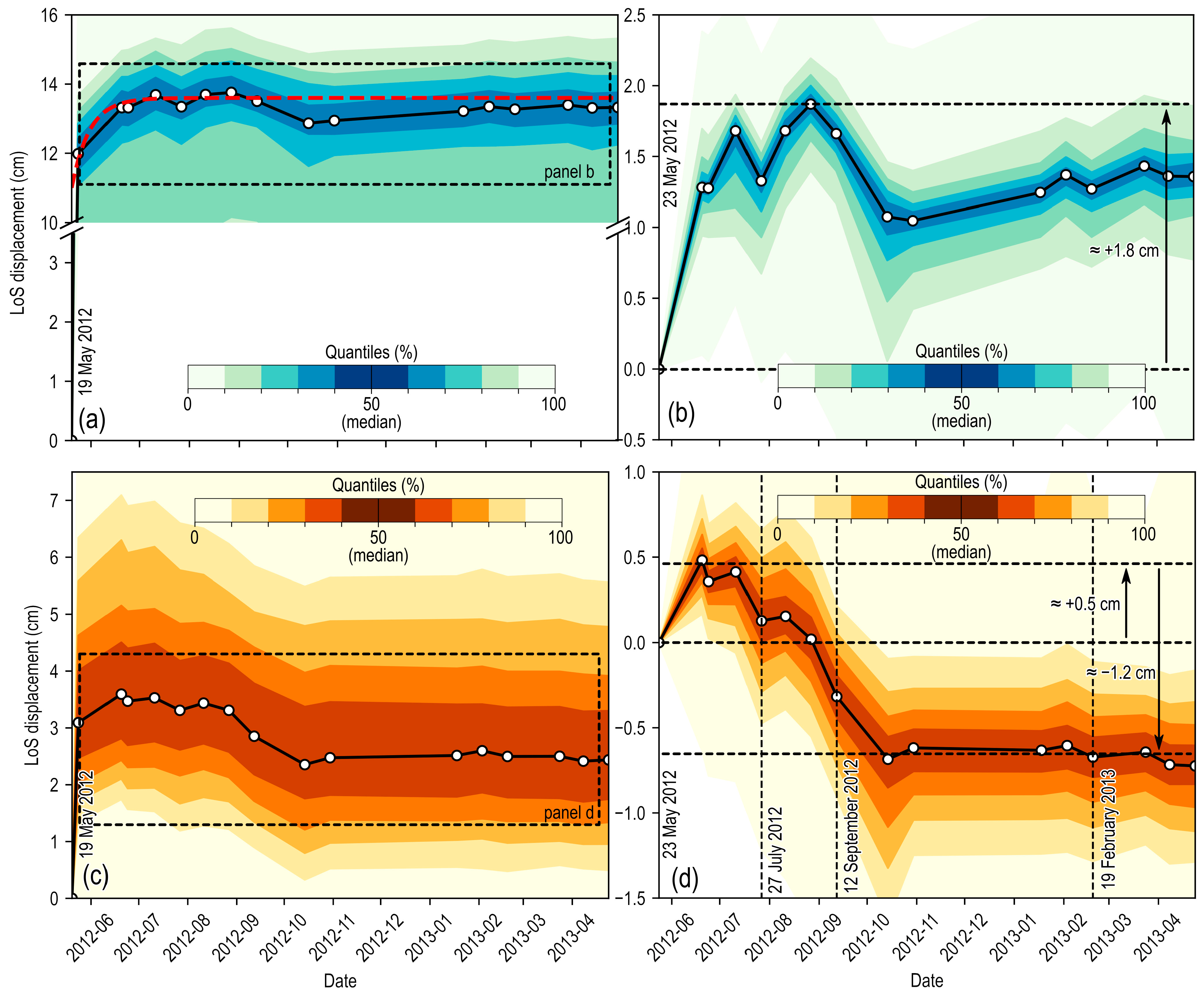
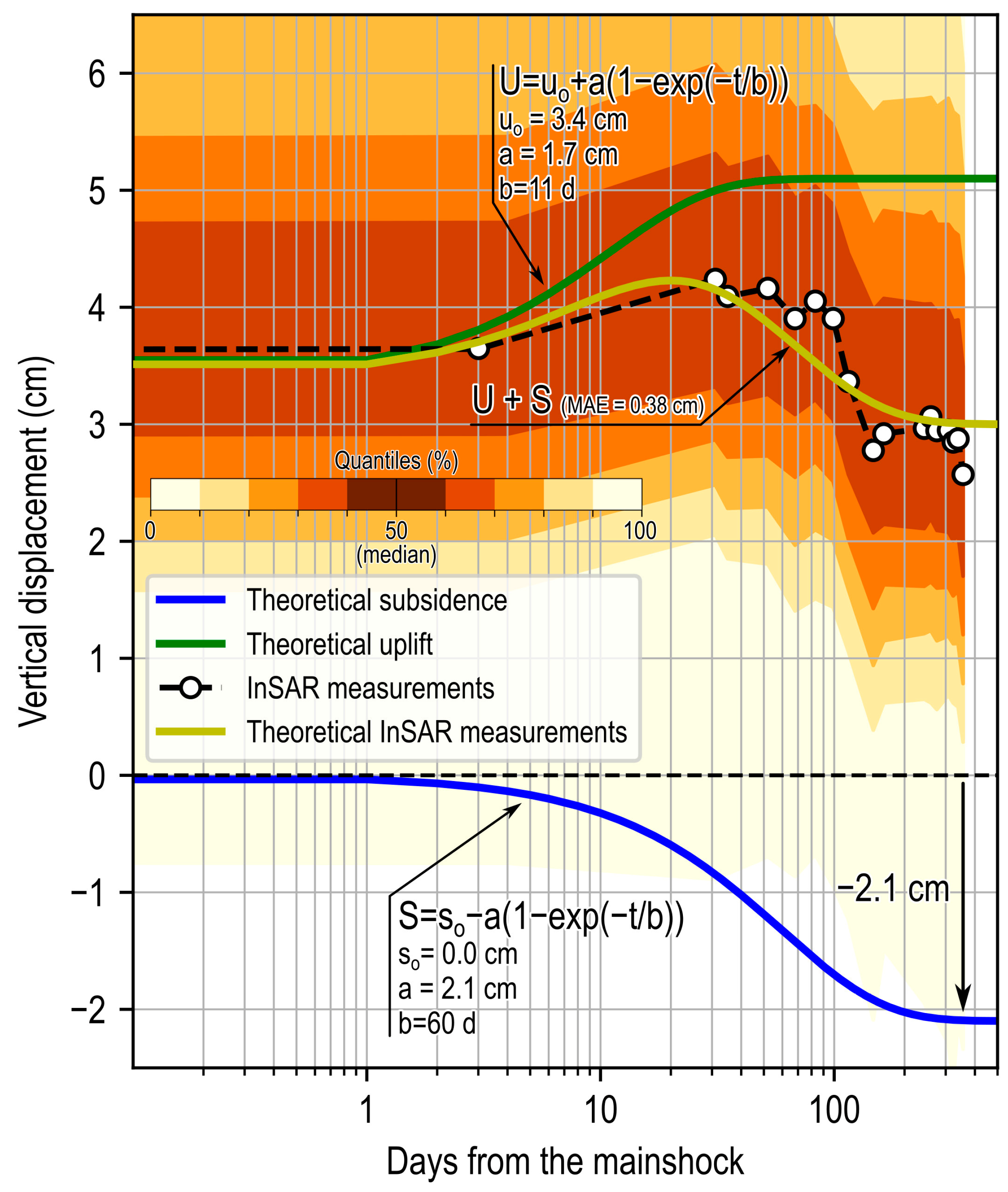
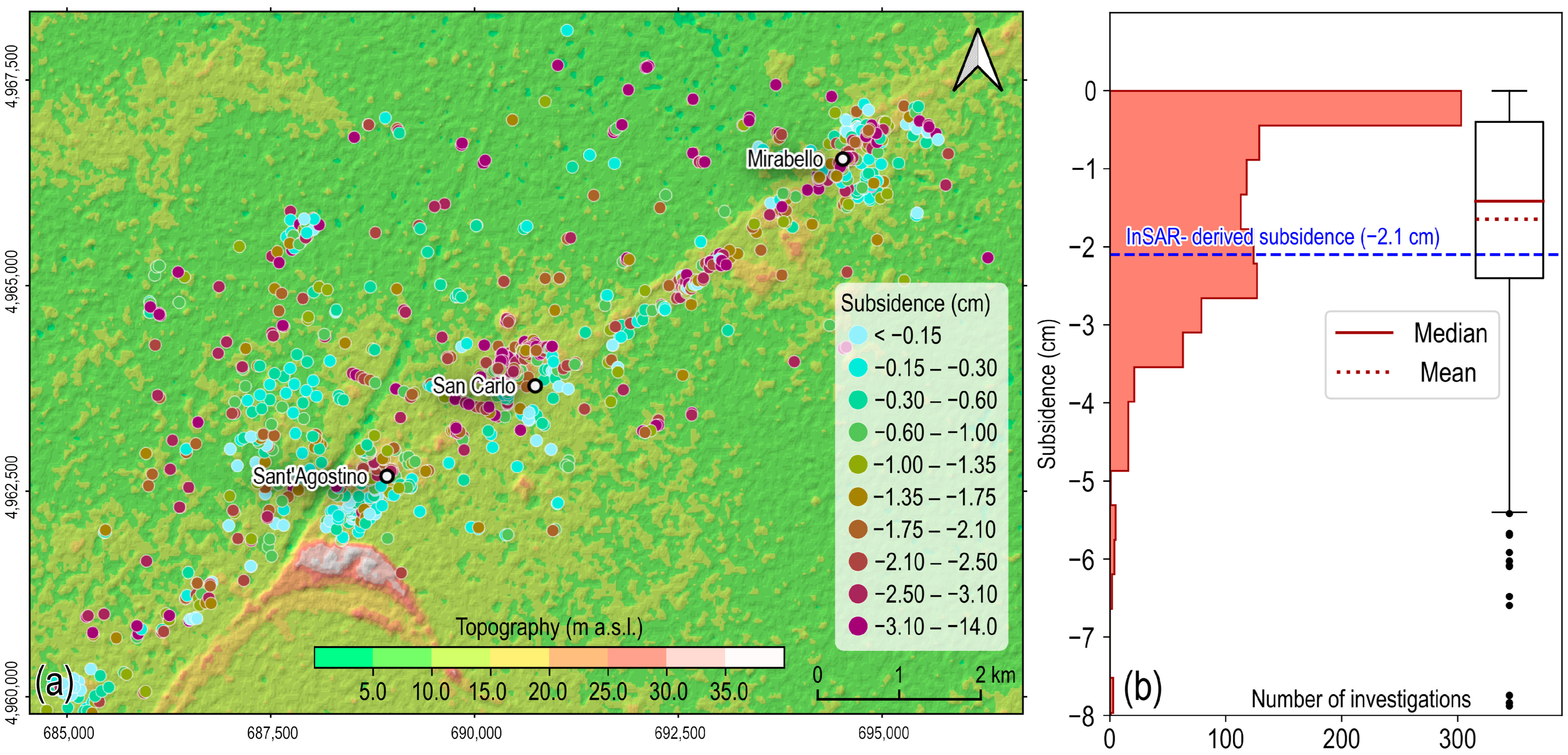
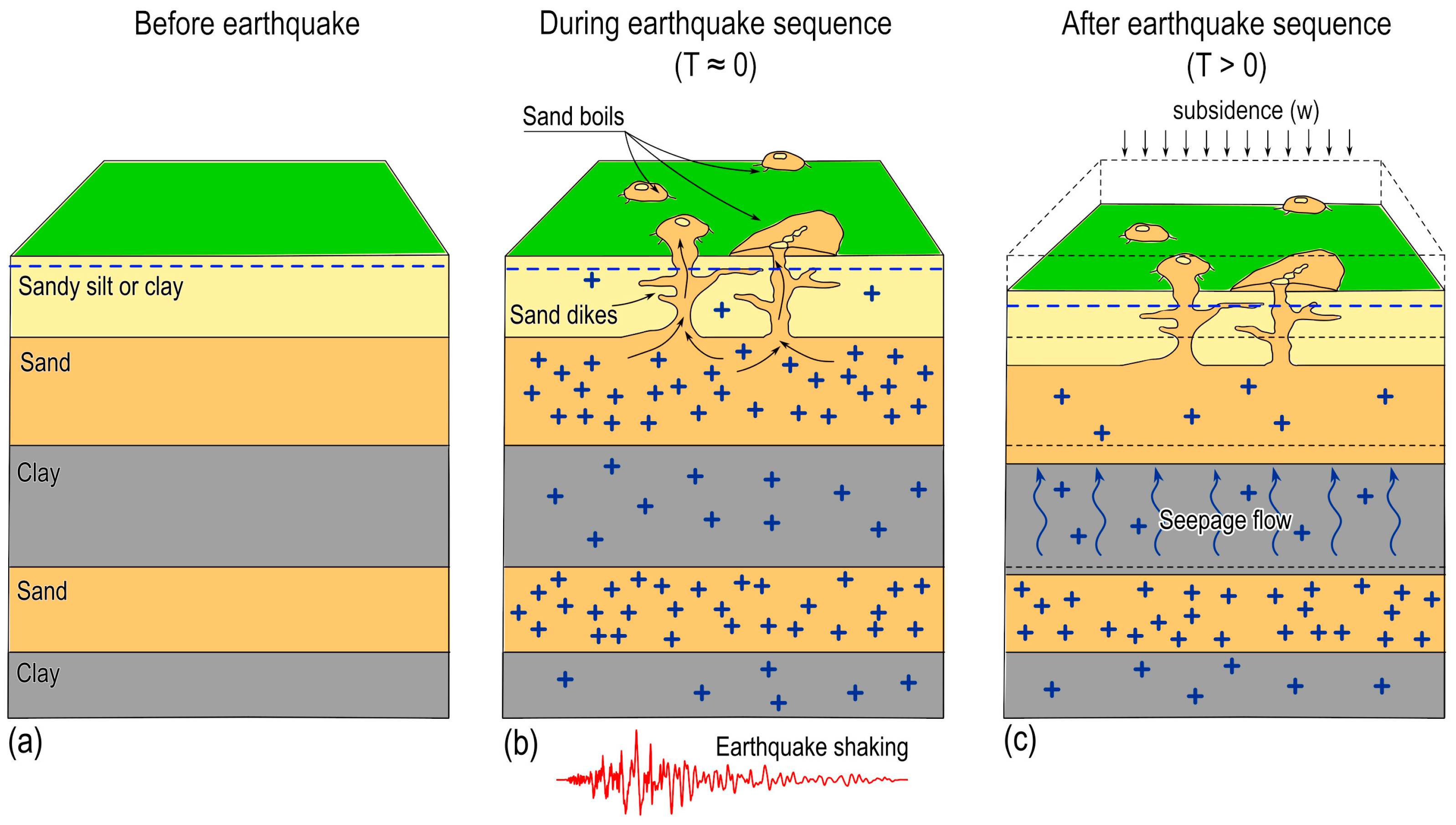
Disclaimer/Publisher’s Note: The statements, opinions and data contained in all publications are solely those of the individual author(s) and contributor(s) and not of MDPI and/or the editor(s). MDPI and/or the editor(s) disclaim responsibility for any injury to people or property resulting from any ideas, methods, instructions or products referred to in the content. |
© 2024 by the authors. Licensee MDPI, Basel, Switzerland. This article is an open access article distributed under the terms and conditions of the Creative Commons Attribution (CC BY) license (https://creativecommons.org/licenses/by/4.0/).
Share and Cite
Albano, M.; Chiaradonna, A.; Saroli, M.; Moro, M.; Pepe, A.; Solaro, G. InSAR Analysis of Post-Liquefaction Consolidation Subsidence after 2012 Emilia Earthquake Sequence (Italy). Remote Sens. 2024, 16, 2364. https://doi.org/10.3390/rs16132364
Albano M, Chiaradonna A, Saroli M, Moro M, Pepe A, Solaro G. InSAR Analysis of Post-Liquefaction Consolidation Subsidence after 2012 Emilia Earthquake Sequence (Italy). Remote Sensing. 2024; 16(13):2364. https://doi.org/10.3390/rs16132364
Chicago/Turabian StyleAlbano, Matteo, Anna Chiaradonna, Michele Saroli, Marco Moro, Antonio Pepe, and Giuseppe Solaro. 2024. "InSAR Analysis of Post-Liquefaction Consolidation Subsidence after 2012 Emilia Earthquake Sequence (Italy)" Remote Sensing 16, no. 13: 2364. https://doi.org/10.3390/rs16132364






